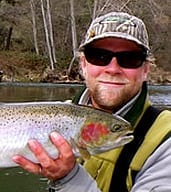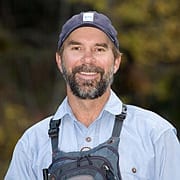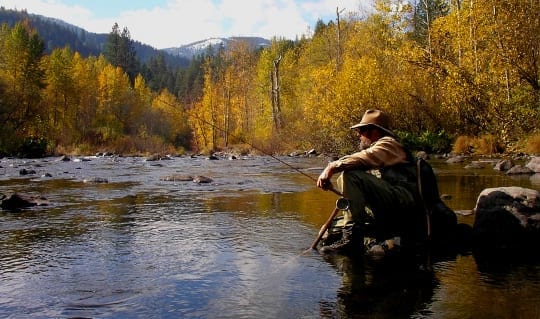The Top Fall Fly Fishing Tips of California’s Fly Fishing Guides
Einstein said “The only reason for time is so that everything doesn’t happen at once,” and Fall is the time of year when fly fishermen learn Einstein lied.
As far as fishermen are concerned, everything is happening all at once, and the big decision isn’t so much “Where is the fishing good?” as it is “How do I choose?”
Take a last couple stabs at the high country’s tiny streams and lakes? Chase the October Caddis hatch (the bug that looks pops out of the water like a small orange hummingbird) on the Upper Sacramento and McCloud Rivers?
Follow the steelhead on the Trinity or Klamath? Hope for the fish of a lifetime on the Lower Sacramento? Chase the big spawning Brown trout as they migrate from lakes to moving water? Or chase the last of the hatches on the spring creeks?
Given the number of choices afforded California’s fishermen, it’s never easy. That’s why CalTrout asked three California fishing guides/teachers to talk about their favorite places to fish in fall — and to offer up a handful of useful fishing tips.
Ralph Cutter runs the California School of Fly Fishing and fishes the Truckee/Lake Tahoe area. Dave Neal guides the Eastern Sierras, and Craig Nielsen of Shasta Trout fishes all over California’s northern streams and rivers.
In simple terms, if you like variety, California remains one of the best states in the country for fishing. We’ll let the experts tell you why…
Ralph Cutter, Owner, California School of Fly Fishing

Ralph & Lisa Cutter
Q: How is fall fishing different? Where do you like to fish?
My favorite fall fishing is at or above timberline in the High Sierra. I’m allergic to crowds and from September until the snow sticks for good, the high country is pretty desolate.
In the mountain fall, wildlife is in high gear as it prepares for winter. Deer are heading down slope with the lions right behind. The Clark’s nutcrackers are raucous and belligerent as they bury pine nuts and chase the squirrels from their larder. Pika are drying hay with a fervor and their sharp “JEEP” cries echo from the granite walls throughout the day instead of just at dusk and dawn. And of course, trout can’t seem to get enough food to satiate their pre-winter gorge.
The hatches are mostly done, but Sierra trout aren’t very hatch dependent at any rate. They might key in on midges at low light but in general, terrestrials are the name of the game. Grasshoppers, ants, and beetles are the entree and any likely looking imitation will draw grabs.
The trout will usually oblige your dry fly presentation, but if they seem a bit reticent, allow your offering to sink and that will likely be all the encouragement they need.
Q: Your Favorite Tips for Fall Fly Fishermen?
- Stay low and fish close. As a rule anglers cast far too much and far too far. Not only do you have more control over the fly up close, it is simply more fun and effective.
- Be aware of the sun. Fall shadows are long and harsh and nothing spooks a fish faster than your dark shadow cast across a pool.
- Watch the water temperature. In the summer trout prefer to feed in the cool hours of morning and evening, but as the fall progresses they will turn increasingly to mid day feeding.
- Brookies and browns get increasingly territorial as spawning season approaches. Fish streamers tight to likely cover and crowd the fish. Orange and black streamers are my favorite; perhaps they imitate the orange and black fins of trespassing brook trout; perhaps it’s only because Halloween is close at hand.
Ralph Cutter Bio
Ralph Cutter — along with his wife Lisa — has owned and operated the California School of Flyfishing since 1981. Their classes are held in Nevada City and Truckee. Ralph is a past Cal-Trout board member, Regional Manager, and Streamkeeper for the East Carson, Truckee, and Upper Yuba Rivers. He’s also published several books, including the convention-challenging Fish Food, where he donned a mask and flippers to see what fish eat — and how.
Dave Neal, Owner of Reel Mammoth Adventures

Dave Neal, Reel Mammoth Adventures
Q: How is Fall fishing different from the rest of the year in your region?
The fall season is a stunning and beautiful time to visit the eastern Sierra! While the deciduous tress turn their magical yellow, orange and red – so too, the fall spawning brookies and brown trout transform into gorgeous hues of deep yellow, orange, red and even iridescent blue.
The days are shorter and mornings are crisp and cool – the sense of impending winter can be a powerful motivator to get anglers outside for one last fishing trip in the mountains. The fall season has a distinct moodiness that evokes feelings of anticipation with twinges of reflection. Fly fishing being is a contemplative activity… the fall season complements our sport well.
As an added bonus: the kids are back in school – the summertime tourists are gone! The woods, trails, lakes and streams are left for the serious anglers to enjoy in relative solitude. You might just enjoy your favorite “fishing hole” all to yourself.
Q: Where Do You Prefer To Fish In the Fall?
Fall season either finds me chasing the big brown trout of Crowley Lake, Upper Owens, and East Walker Rivers… or hiking for the smaller brookies in the mountain streams.
The fall season is synonymous with big brown trout hunting! As a fall spawning trout, big browns are on the move and aggressive towards… well, just about anything that comes in front of them.
Some days I am content to chase smaller fish, solitude, and enjoy fall colors. I pull on my hiking boots instead of my wading shoes and head for the hills in search of the horny brook trout instead.
Q: Your Favorite Tips for Fall Fly Fishermen?
-
The seasoned fall angler better be well rounded — you’ll be fishing everything from large dry flies to tiny dry flies to nymphs to even streamers too!
-
Be ready for those encounters with large, migratory, hormonally driven fall spawners, which can be huge (especially if they’ve run up a stream connected to a lake).
-
Educate yourself about the particular fishery you are visiting. Are you targeting primarily resident fish or migratory pre-spawn fish? What species of trout reside there? What are the common fall bug hatches, how do you identify them, and are they active mornings or evenings?
-
Take a camera, and a bird ID book; trout live in beautiful places, and fall colors can be breathtakingly spectacular. You may encounter lots of migratory birds, and we have as much fun trying to ID birds as we do catching trout.
-
With the cooler daytime temps, you may fish all day long, so bring plenty of food and water.
Dave Neal’s Bio
Dave Neal is the owner of Reel Mammoth Adventures which offers walk & wade, drift boat trips and charter boat trips in the Mammoth area (including Hot Creek, Owens River, Crowley and many others). He also offers late fall/winter drift boat steelhead trips on the Trinity River.
Craig Nielsen, Owner of Shasta Trout (Mount Shasta based outfitter and guide service)

Craig Nielsen, Owner Shasta Trout
Q: How is Fall fishing different from the rest of the year in your region?
The fall season in the shadow of Shasta is particularly special because it is the time of year when all of our rivers are fishing well, so where I fish is a matter of how I’m feeling.
On anadromous rivers (the Trinity, Klamath and Lower Sac), King Salmon are moving in, and trophy trout and steelhead are gorging on the eggs — and providing anglers their best opportunity to hook the fish of a lifetime. Flows are low and fish are often concentrated, so anglers who prefer to swing flies should really gravitate to the Trinity and Klamath in the fall.
On freestones likes the McCloud, Upper Sacramento, and Pit, hatches of Blue Wing Olives and the much-anticipated October Caddis take center stage. Hatches on spring creeks — including Hat Creek and Fall River — also pick up, with Blue Wing Olives and a few Mahoganies joining some lingering Pale Morning Duns. Technically oriented anglers will find plenty of chances to test themselves before season closes on November 15th.
Q: Where Do You Prefer To Fish In the Fall?
Living and fishing in the shadow of Mt. Shasta provides a lot of fly fishing options. With a few minutes I can fish October Caddis dries on the Upper Sac or McCloud, or take a half day or more to swing flies with switch rods on the Klamath or drift the Lower Sac for big ‘bows and an occasional steelhead.
I can also play the weather; if it’s drizzly, I can opt to stake out a run with fish rising to Blue Wing Olives or perhaps swing flies through a shallow tailout for some Steelhead who have just moved in during the low light conditions. On a bright sunny day, I might opt to lay on the sunscreen and enjoy a lazy day drifting the Lower Sac or casting to selective risers from a pram on Fall River.
Q: Your Favorite Tips for Fall Fly Fishermen?
- In low, clear water the fish are easy to find but also easily spooked, so stealth on the angler’s part is essential
- Slow your pace a bit, observe closely, and plan your approach before making that first cast
- Fall colors are splendid, so don’t forget to pause during your fishing and take a look around
Guide Bio
Craig Nielsen is the owner and operator of Shasta Trout. A Northern California native, he has been chasing trout with a fly rod for 49 years and guiding professionally since 1992. Having fished all across the west, B.C. and Alaska he especially appreciates the angling diversity Mt. Shasta offers. A certified casting instructor, he taught at Mel Krieger’s school and was one of the first authors writing about switchrods. Craig has been a featured guide for Fish First, Flywater Travel, The Ashland Flyshop, Leland, Ted Fay, The Clearwater House and The Fly Shop.






6 Comments
i love the klamath, trinity, and calaveras rivers for fall fishing.
Thanks for your best effort but i have a one question “what are the 3 most important things you wish you knew when you started fly fishing?”